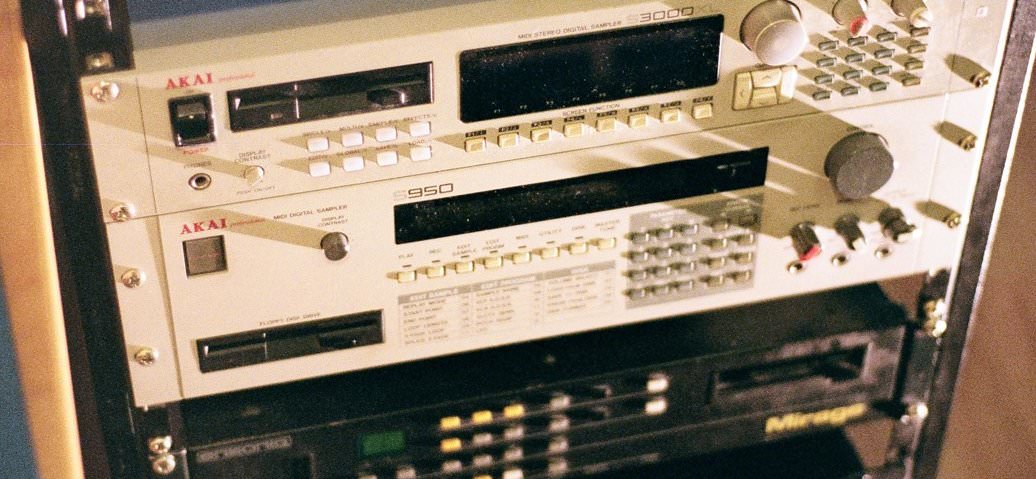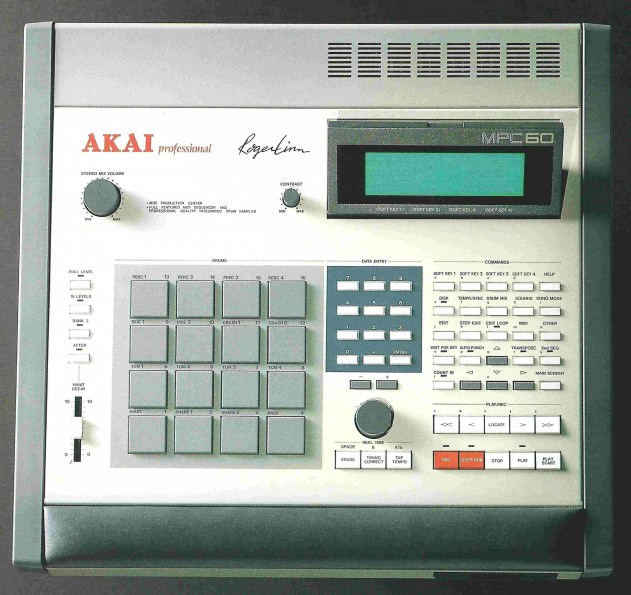
u-he are makers of award-winning software synthesisers and effects including Diva, Repro-1, Zebra2, Hive, Bazille, Presswerk and Satin.
Visit U-he

u-he are makers of award-winning software synthesisers and effects including Diva, Repro-1, Zebra2, Hive, Bazille, Presswerk and Satin.
Visit U-he
The Akai MPC60: a 12-bit classic
In general, the earlier (or cheaper) the machine, the lower its maximum bit depth and sample rate.
8-bit digital drum machines include the Linn LM-1 and Oberheim DMX (both introduced in 1980), using samples recorded at 28 kHz or less. Peek inside a DMX and you’ll see a series of individual voice boards that can be independently tuned up or down. The output of each is mixed in the analogue domain. Some voices make a feature of digital aliasing to give the drums more bite.
Early samplers like the E-mu Emulator, with its 8-bit, 27 kHz engine, were expensive but not particularly accurate by today’s standards. The legendary 8-bit Fairlight CMI series II would stretch those specs to 32 kHz sampling (with 8-note polyphony), and do much more besides, but only if you could afford the £90,000 it would cost in today’s money.
By the mid 80s, budget models started to arrive. Ensoniq’s Mirage was introduced with a similar sampling spec (on paper) but cost a fraction of the price.
In the latter half of the 80s, notable 12-bit drum/sequencing systems included the E-mu SP-1200 and Akai MPC60. The MPC sampling engine was based on that of the Akai S900 and reached up to 40 kHz.
It wasn’t long before the battle for affordable high-fidelity sampling finally reached ‘CD quality’ with the release of the Akai S1000 in 1988. Despite this, these are still sought for their sound – evidence perhaps that technical specs rarely provide the full picture. Some sampling purists consider most samplers introduced after this point as lacking in ‘warmth’, but at the time, that was a selling point in its own right – before the widespread use of computers for digital audio, neutral, uncoloured sample playback was highly desirable.
For those of us without access to vintage samplers, there are still ways of experimenting with some relatively straightforward techniques to achieve different forms of digital flavouring.
A good place to start is with a bit crusher – such as the Toneboosters plugin we used previously or something like D16’s excellent Decimort – set for 12 or 8-bit and sample rates of a half, third or even quarter that of your original signal (assuming you’re working with 44.1 kHz sound sources).
Let’s start with an old-school drum break that has a distinctive analogue vibe:
Dropping it to a lower resolution is an effective way to add a retro feel:
Having a plugin doing the processing allows you to experiment with odd, and somewhat unrealistic settings. This is the break converted to 3-bit playback, but maintaining the original sample rate:
A 3-bit system has only eight distinct signal levels (including zero) with which to represent an audio signal. In reality, a 3-bit, 44.1 kHz sampler isn’t something you’re likely to come across in hardware, but it’s worth trying some of these unlikely combinations of settings to see if they work on specific sounds. Note how most of the drums don’t respond too well to such a low bit depth, but the snare actually sounds pretty good at this ultra-crunchy setting. It’s a good demonstration of the fact that the best settings depend heavily on the source material.
A more realistic choice for flavouring is 12-bit at a 16 kHz sampling rate, and this time with a more sympathetic anti-aliasing filter. The anti-alias filters soften the overall result, removing some of the artificially generated high-end.
A good demo of aliasing issues can be heard by taking an upward sine wave sweep and converting it to a lower sampling rate without any pre- or post-conversion filtering:
Notice how you can hear frequencies that are not harmonically related to the original. Here you even get a downward frequency created as the original sweeps upwards.
The Linn LM-1 took advantage of the some of the byproducts of the lo-fi digitisation process to give some of its drum sounds more punch. An analogue low-pass filter was used to smooth its tom sounds, but a short pulse envelope raised its cutoff frequency for a few milliseconds in order to let through higher frequency digital noise and emphasise the attack.
Adjusting the pitch of a sampled sound will also have a bearing on the way digital artefacts may manifest themselves. Here we compare an LM-1 clap (sampled at 22 kHz in the original hardware) with a version tuned on a sampler and re-tuned in a DAW.
Compare this with an 808 clap – created from analogue circuity – retuned in the digital domain:
And now a newly created chord stab processed with some bit crushing:
Notice how pitching down the sounds brings out the character of the lower resolution sample (especially compared to just pitching down a high-res sample).
It’s important to note that although we can approximate what happens when signal is digitised, in the real world any associated analogue circuitry also plays a significant role. In a typical sampler, this might include a mic pre-amp or line-level buffering amp on the input, and analogue output stages (after the digital-to-analogue converter) vary enormously. Even elements that aren’t directly in the signal path, such as the power supply, will have an effect.
An easy way to approximate this effect is to apply some analogue-style saturation or overdrive before applying the bit depth and sample rate reduction.
Just like the analogue world, it isn’t always perfect sound quality that’s sought, but imperfection and sonic character. Through a combination of simple processes including bit crushing, sample rate reduction, saturation, filtering and EQ it’s possible to replicate some of the character of vintage samplers, but of course this only scratches the surface of the vintage-digital aesthetic. Nevertheless, experimenting with lower-resolution digital audio should be considered an essential tool for adding character to your productions.
14th August, 2015

u-he are makers of award-winning software synthesisers and effects including Diva, Repro-1, Zebra2, Hive, Bazille, Presswerk and Satin.
Download the demos and try them for yourself at www.u-he.com
Attack Magazine is funded by advertising revenue. To help support our original content, please consider whitelisting Attack in your ad blocker software.
x
11.02 AM
the mpc60 is a different kind on animal. it has 12bit non-linear sampling engine. not same as the s9xx series.
09.43 PM
The zoom sampletrak is my favourite for crunching sound. You can still get them cheap and you might just fall in love with the thing’s easy workflow and some cool effects.
04.35 PM
Big fan of the vintage sound! TR 707s, 909s, Oberheim DMX…love them all! Dabeull has a pretty sweet set up of them too:
http://frenchshuffle.com/2015/05/24/get-in-the-studio-with-dabeull-dastudio-10/
Seems like the vintage sound is definitely making a huge comeback in the contemporary music scene.
10.53 AM
Would recommend that you check out TAL Sampler for this kind of duties!
09.02 AM
Thanks for pointing out the AA filter on Decimort. I did’nt realise it was there. Used some of these techniques on my current project. Big up!